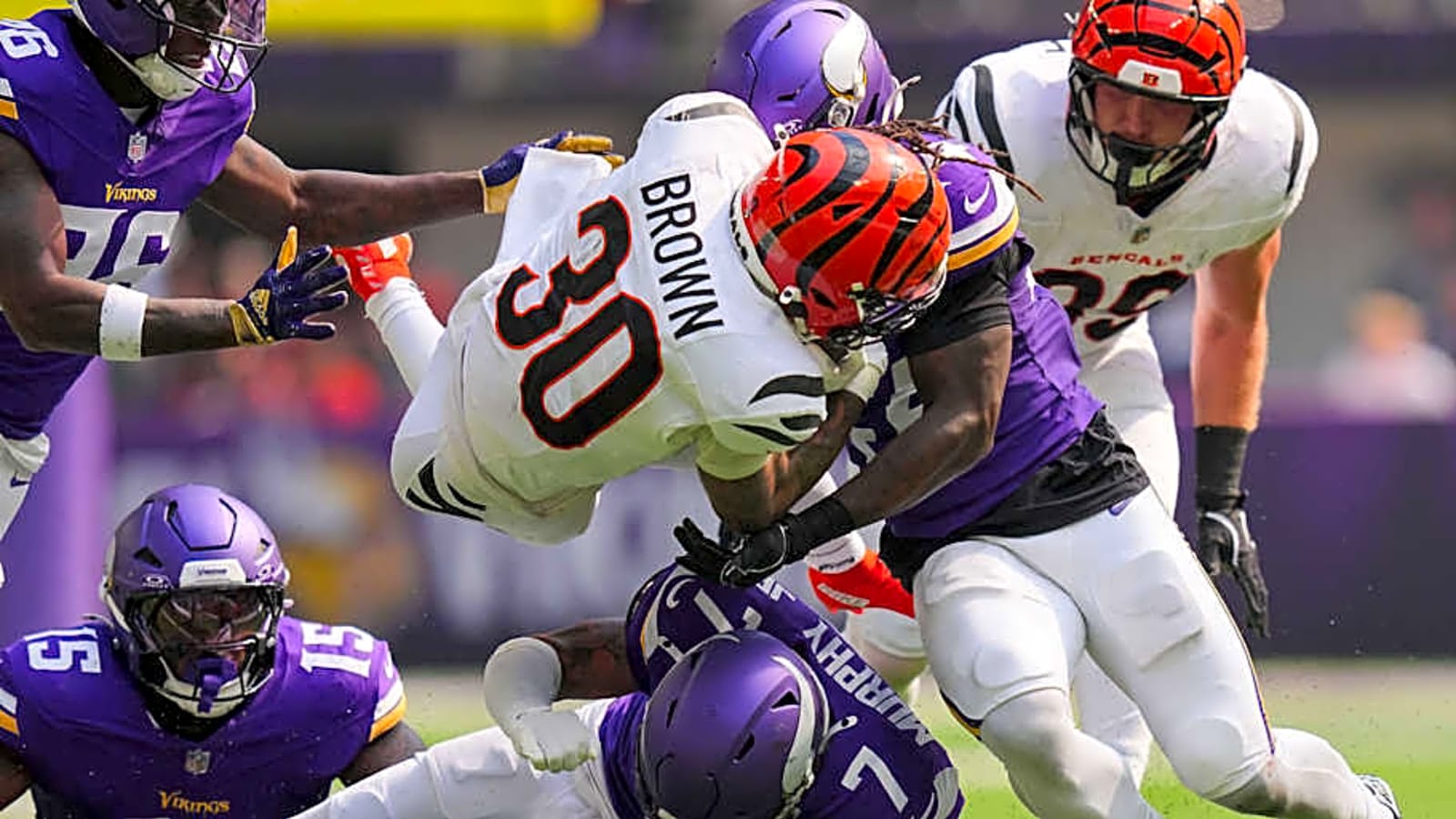
The Bengals broke a record this week.
Chase Brown's 47 attempts are the most for any player in NFL history with fewer than 100 rushing yards in the first 3 games of a season. Brown is currently averaging 2.0 yards per carry. He finished with just three yards rushing on four attempts in Sunday's loss to the Vikings.
Brown has the worst rushing success rate of all qualified runners according to NextGenStats. He has 18 more yards after contact per game than he does actual yards per game.
Brown has -54 yards before contact on the season. The Bengals' running game is completely broken and Sunday’s performance against the Vikings threw it into the spotlight. It takes a cumulative effort to have a run game this porous.
Let's take a look at the film:
Offensive Line
First and foremost, the offensive line is struggling mightily as a unit when it comes to run blocking. There are missed assignments, failures of technique, failures of athleticism, and failures in communication.
This wide zone snap features multiple issues:
— Walter (@Pff_Walter) September 23, 2025
Dalton Risner doesn’t even lay a finger on the nose tackle and Ted Karras does not provide a brace arm to help him.
This causes the fullback to abandon his assignment and take the nose while Risner climbs to the second level and takes the fullbacks assignment. This actually ends up working, but Dylan Fairchild gets dominated at the point of attack and the Vikings bring a defender off the backside that is unaccounted for in the blocking scheme.
Even if none of that happened, the play would be dead because Amarius Mims allowed the backside end to cross his face and get involved in the play. This was the very next play:
— Walter (@Pff_Walter) September 23, 2025
This time the Bengals are running inside zone at a double mug look. They have a blocker for every defender and yet one guy comes free to the back and another clogs the hole with Orlando Brown Jr. Brown doesn’t have the athleticism to cut the defensive tackle off and is playing high with his chest out allowing the defender to knock him back.
The other end is a failure in communication as the Vikings are running a 3-man game to that side with the end looping around to the inside. Handling this on offense is the same as if it were pass protection. Karras and Risner should hand their defenders off and then Karras needs to be ready to take on the looper. Instead, they all block the guy in front of them which makes it impossible for Mims to block his guy as he’s running in the opposite direction.
The very next run was dead on arrival because of the offensive line:
— Walter (@Pff_Walter) September 23, 2025
Karras allows for the nose to drive him backward and reset the line of scrimmage, while Fairchild has his head down and whiffs on the defensive tackle. By the time the back receives the ball, Karras and Fairchild’s defender are about a yard in front of him. There is nothing that any running back could do in this scenario.
Somehow the Bengals offensive line had a second play where a nose tackle went unblocked:
— Walter (@Pff_Walter) September 23, 2025
This play appears to be another communication error. This play is so botched it’s a little difficult to tell what it was even supposed to be. Due to some of the previous plays in this game, it would seem as if the right side of the offensive line needs to down block to their inside rather than fan to their outside. That would leave the end for Drew Sample to kick and then Cam Grandy would climb to the second level and lead the way. Instead of that play, this ends up as an Oklahoma drill where the nose gets a running start to hit Brown in the backfield.
These were just some of the examples of how poor this offensive line blocked. Every member of the offensive line needs to be better. There cannot be this many critical errors on run plays. However, they are not solely at fault for how bad the run game looked on Sunday.
The Tight Ends
The Bengals elevated Cam Grandy to the active roster for the first time in an effort to run the ball better. Their plan against the Vikings was to establish the run and make things easy on Jake Browning. Instead they burned about half of their first downs with run calls that went for little to no gain.
The tight ends were at fault for how some of these runs played out:
— Walter (@Pff_Walter) September 23, 2025
Look at how much Sample slows down heading into this kick out block. Unsurprisingly he does not move the defender on the kick out block and it causes a squeezed hole. This is the first time all year he’s made this block in a game so his hesitation may be caused by his lack of confidence in making this play.
Still, this play would have worked if Fairchild would have gotten more of the linebacker instead of allowing him to be a large presence waiting in the hole for the running back. If either one of those blocks were made better on this play, it could have gotten Brown into the open field with just defensive backs left to make a tackle.
— Walter (@Pff_Walter) September 23, 2025
It’s the same concept here except this time it’s both tight ends who are at fault for this play not working. Sample is slow into contact again and creates no movement, while Grandy is absolutely dominated at the point of attack by his defender. Grandy is probably more at fault because of how bad he loses on this play. He gets driven back so far and fast that Fairchild has nowhere to go.
This has been the worst season of Sample’s career so far. He has struggled as a run blocker. Typically that is his calling card on offense.
Mike Gesicki is really a wide receiver and Noah Fant cannot do all of the things that Sample does from a blocking standpoint. Fant is more of a guy who blocks well in space but he struggles when asked to block down linemen. Grandy can do some of what Sample does, but it did not look like it against the Vikings.
Play Calling
At some point, the Bengals needed to adjust their gameplan. The Bengals ran the ball on first down on all four of their opening drives in the first quarter. Brown had -1 yards on three runs, while Ja'Marr Chase had nine yards on one run. The Bengals somehow accumulated -35 expected points added on early downs on Sunday which seems impossible. They averaged -0.81 expected points per play on early downs. They essentially lost a point every time they took a snap on first or second down. Some of that has to be traced back to the play calling within the game.
It’s also worth pointing out that the power concept with a motion tight end they ran multiple times in this game had nothing else built on it. Every time they got under center and motioned the tight end, they ran the same play. It reminds me of when they would run that exact same concept with Erick All Jr. last year and they never built anything off of it.
There needs to be a complement to every run that is utilized by a team. Whether that’s play action or a run concept that complements it. The Bengals seemed to just throw concepts at the wall and see if they stuck.
The run game for Browning was also poor against Jacksonville, but rather than feature an abysmal run game, they threw the ball on early downs over 70% of the time. This is a team that is built to throw the ball.
The offensive line prioritizes pass setting and the pass catchers are the most talented members of the team. With that said it’s a difficult life for a quarterback to be put into a situation where the best offense comes from the drop back passing game. It worked for the Bengals last year, but that’s because of Joe Burrow’s brilliance.
Burrow has masked a lot of flaws with this team. They won't have him for at least the next three months, which means they need to solve some of their issues—fast.
More must-reads:
- Major updates on T.J. Watt's lung issue, status for Dolphins game revealed
- Jim Harbaugh breaks silence on Sherrone Moore situation
- The 'Oldest 4,000-passing-yard seasons' quiz
Breaking News
Trending News
Customize Your Newsletter
 +
+
Get the latest news and rumors, customized to your favorite sports and teams. Emailed daily. Always free!








